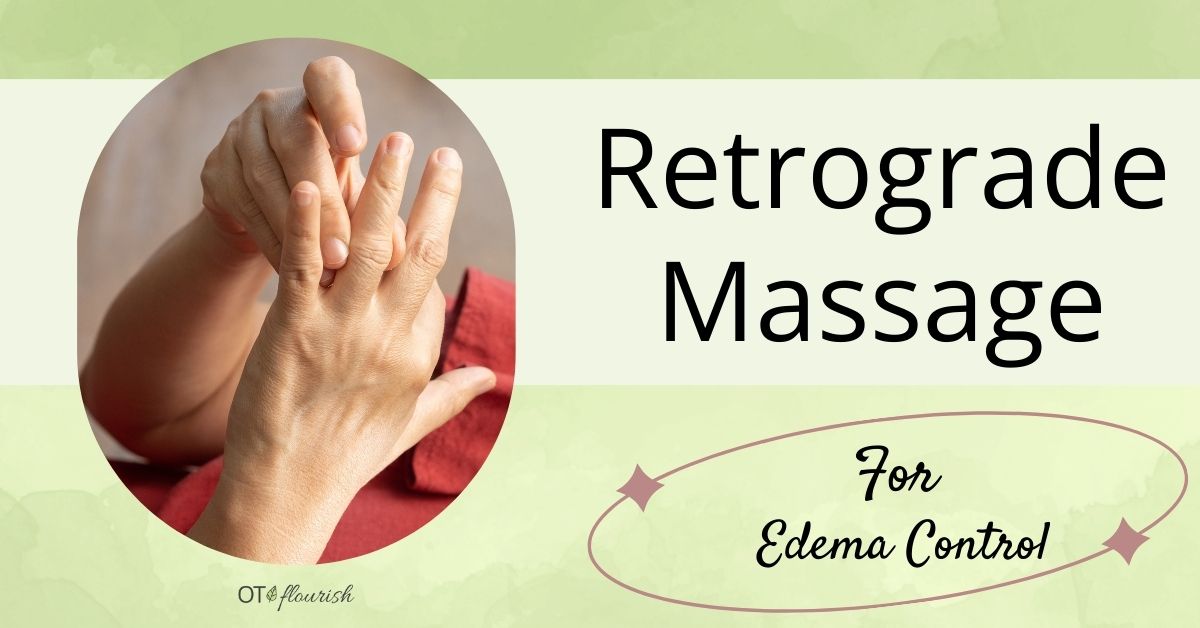I remember as a new grad occupational therapist, when I was first asked to provide a retrograde massage to a patient. I was so nervous!
Was I providing the right amount of pressure?
Was I moving in the right direction? So many questions!
I was so grateful for fellow OT support at that moment (and many other moments) but unfortunately, not all of us have the needed support for one reason or another. So, that’s what Seniors Flourish is here for.
We’re your support – Let’s review!
Retrograde Massage 101 ☺
What is it and what is it used for?
This type of massage is used to assist in reducing edema, or swelling, including pitting edema (if you are looking for how to grade pitting edema, members of the Membership have these resource here). It is mostly used for hand swelling, but can be used in all extremities.
Essentially, what we’re doing with providing retrograde massage is pushing the fluid that is causing the edema, from the fingers back towards the heart so that it can be reabsorbed into the bloodstream.
Retrograde massage must be supervised and advised by a medical provider due to contraindications, it’s effectiveness with a specific diagnosis or a need for alternative options due to a patient’s specific needs and medical history
When is it appropriate to provide retrograde massage?
Think about this: Hand swelling is a normal response to injury. When swelling occurs, our body is acting in the healing process. It takes the healing properties through the circulatory system to arteries within the wounded area and returns it through the arteries on the outside of the wounded area. In order to assist with the return of fluids we use retrograde massage and other modalities.
Typical diagnoses to use it with?
Retrograde massage is recommended when the swelling is due to inactivity, or lack of movement to the extremity due to the injury. Diagnoses that typically endure this type of swelling and are appropriate to use hand retrograde massage include fractures of digits or wrist and CVA.
Fractures are typically immobilized to allow healing and would benefit from external assistance to move fluids to be reabsorbed. A hemiparetic extremity is also immobilized due to lack of ability to freely move and may demonstrate edema. In this case, retrograde massage is also recommended.
Contraindications
Take contraindications into consideration as well prior to providing retrograde massage.
- Be aware of the reasoning behind the swelling.
- Make sure that there isn’t any underlying issue causing the edema besides immobility, such as a DVT. Any underlying reason for swelling could potentially make the massage dangerous to the patient.
- Be aware of existing heart conditions.
- It may affect tolerance of the amount of fluid being pushed back and the heart may not be able to manage high levels of fluids, so please closely monitor.
- Be aware of the lymphatic system.
- Make sure the lymphatic system is functioning as it should.
- If not, for example with lymphedema, the retrograde massage will be ineffective as a different system would be affected in this case.
- Make sure the lymphatic system is functioning as it should.
How do I provide retrograde massage? Any strategies to provide it effectively?
Retrograde massage is pretty simple and can be easily taught to reduce swelling in hands.
- Take a lubricant (most times lotion is used) to reduce friction during the massage.
- Then massage the finger/wrist/hand towards the elbow/forearm with moderate pressure (gauging a patient’s tolerance).
- Only go in the direction of fingertips to wrist/elbow (distal to proximal) and repeat for five to fifteen minutes to reduce pressure in the area.
- Go slow as if you are “milking” the hand with even pressure.
Check out this “how to video” on retrograde massage!
What are other strategies I can use to work on hand swelling?
Many other practices are used alongside retrograde massage and recommended per a 2017 study. Always talk to a health professional before integrating any of these strategies for hand swelling.
- Positioning is very important in order to allow for gravity to assist fluids back to the bloodstream.
- Educate patient on positioning extremity above heart level, using pillows as needed, when laying in bed, reclining, or sitting in a chair.
- Compression garments, such as edema gloves, are also used to help move fluid as it gradually compresses from fingers to forearm.
- Compress is tighter in fingers and reduces as it moves up the hand to assist with fluid mobility.
- Functional activity is the most important to assist in reducing swelling in the extremity.
- Encourage your patient to incorporate extremity in daily activity and also provide a simple HEP (including fist pumps, opposition, etc) to accelerate reduction of edema.
Let’s try a simple case study to see what you’ve learned.
Your patient is a 56 year old male with an acute CVA. Patient appears with left hemiparesis and neglect and complains of pain in the left arm. You notice pitting edema in his hand. You discuss the patient with the registered nurse (RN) and she expresses the same concern. She reports his extremity is negative for DVT.
What should you check for next?
How do you proceed?

If you answered check for cardiac conditions, you are correct.
At this point, once you’ve double checked that the pt does not have a cardiac condition, you may proceed with educating pt on proper positioning of extremity for awareness of extremity due to neglect and for edema.
Provide retrograde massage for 5-10 minutes and encourage as much functional activity as possible for the patient.
If your patient does have cardiac conditions, hold retrograde massage and utilize other recommended strategies to reduce swelling in his hand (members check out how to use these strategies specifically here in the Strategies for Upper Extremity Dependent Edema).
by Guiselle Miranda, MOT, OTR, CSRS and Mandy Chamberlain MOTR/L





